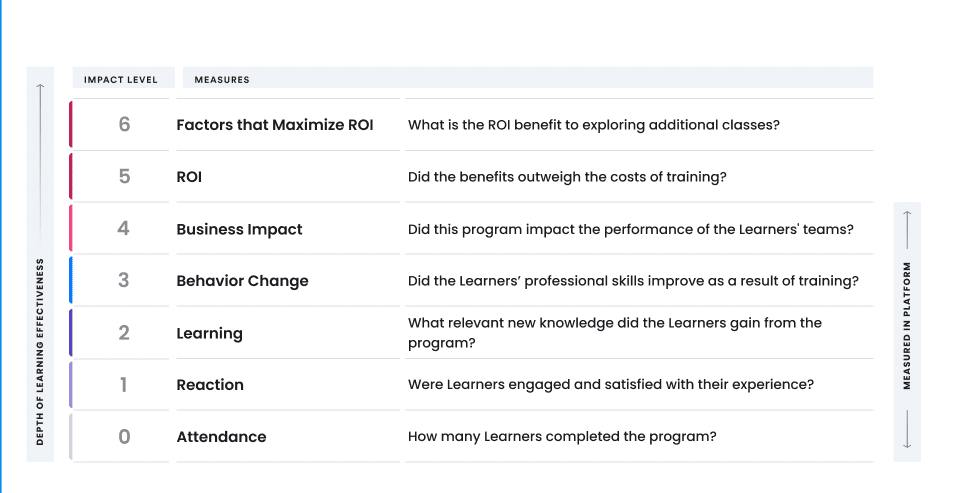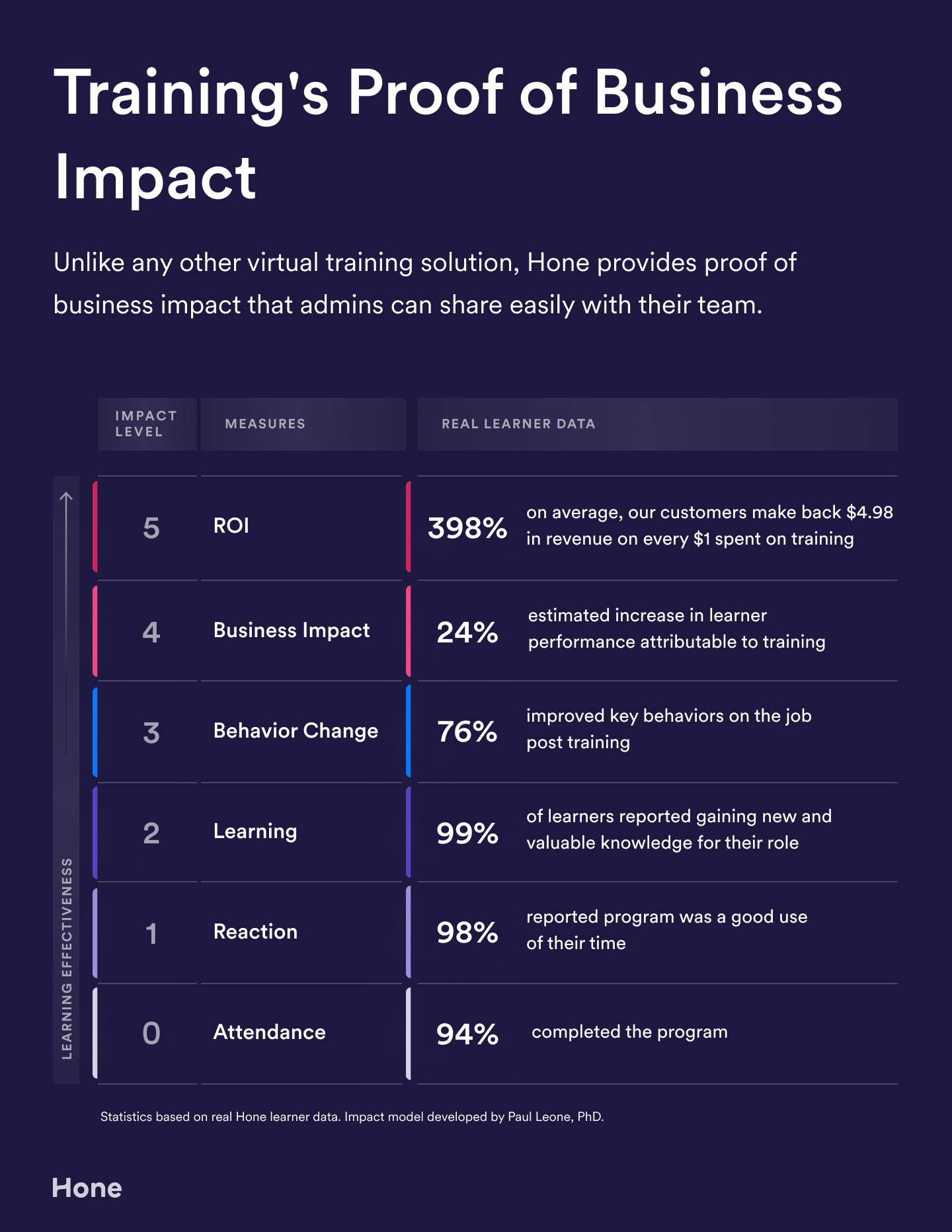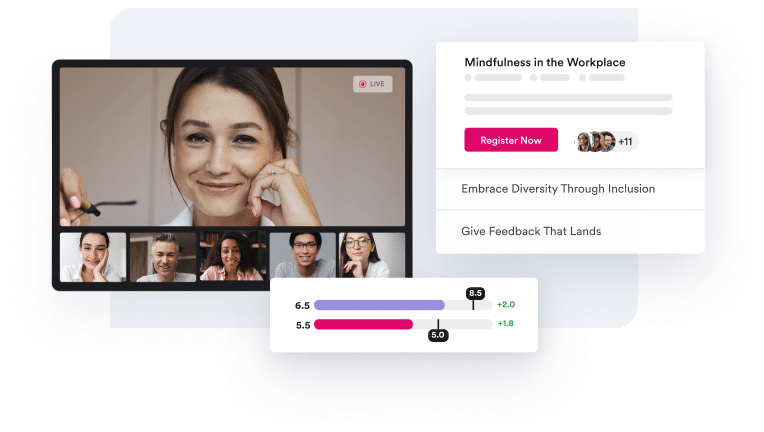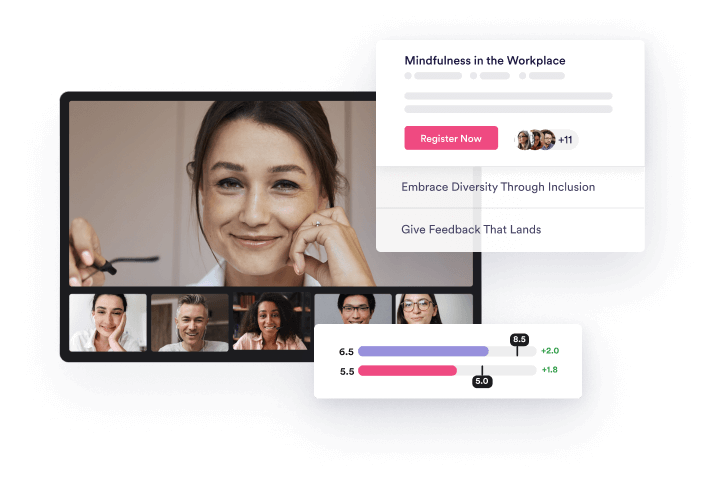The highlight of most business cases is when three popular letters are dropped: ROI. Team leaders are accountable for showing how each investment will be worthwhile. Yet, historically, HR and L&D managers find it challenging to quantify training and development programs. Platforms that drive value and show measurable outcomes will present clear advantages for evaluating these essential workplace components. But, finding a starting point can be tricky. At what point does employee improvement become quantifiable, and what metrics should be included? Here are six ways to measure the ROI of training and development tactics.
6 Ways to Measure the ROI of Training and Development
1. How would you measure the ROI of training?
You’ve assembled talent, configured thoughtful processes, and introduced learning opportunities for personal development and growth. Now what? You have to show how it’s paying off versus what you’ve spent to achieve each goal.
Many expenses can play a role in this scenario. Maybe you have a rewards program for continued learning. Your tech stack is an investment that has to reflect improvement and results. The costs associated with internal teaching and outside consultation can also add up.
Do you have any milestones or formulas used to show success with learning techniques? Other than a gut feeling, do you know if you’re getting it right? Can this kind of thing even be tracked? Then there’s budgeting and proving your worth to the organization. What a tough gig.
Some teams will look to training session attendance rates, employee course satisfaction scores, training surveys, and learning and development assessments and stop there without knowing how to add it all up. The problem is results for these standard metrics or practices don’t fully describe your training program’s impact on your organization.
Continuous learning is essential to a thriving company culture, and training is a significant part of the overall development of your employees. Benjamin Franklin once said, “an investment in knowledge pays the best interest.” Over time, you should have the ability to see the impact of employee training. When trainers and trainees are in rhythm, your organization can achieve great things!
So, how do you present a roadmap or success story demonstrating this value? First, you’ll have to overcome some common roadblocks when measuring the ROI of training your employees.
2. Why is it difficult to measure the ROI of Training?
Many companies are falling short in proving the impact of L&D programs. For example, a recent global leadership forecast found that only 18 percent are gathering relevant business impact metrics, which is why getting buy-in from all departments can be challenging.
Proving the training and development return on investment is problematic because it is time-consuming and complex. There are many data points to collect, it takes an appropriate amount of time to gather feedback, and applying research and analysis on your own is a heavy task.
Often, it can be hard to tell a compelling story with your data because you must equate the business impact of your training to a monetary value. To get an accurate comparison, you’ll need to convert the training impact into additional revenue, cost-saving value, and HR metrics like retention and engagement expenses.
Gathering these qualitative examples and translating them into monetary value can be challenging, and everyone has to be on the same page. If not, your numbers might be skewed and will not present an accurate comparison, or the message might get lost in different terminology across departments.
Many training measurement exercises or evaluations rely on feedback given by employees and leaders. Therefore, it’s essential that surveys, audits, or assessments are clearly understood and accurately reflect the sentiment of each individual. This is hard to do consistently and in a format that removes any bias or confusion. Think about it, just the words used or benchmark figures associated with questions or rankings can impact results that affect your ROI calculations.
Different learning styles across various age groups and experience levels play a role. A recent LinkedIn study revealed that more than 70 percent of talent developers plan to change their L&D program to accommodate Gen Z employees. L&D team leaders must understand these dynamics among how information is retained and described across a broad spectrum of unique personalities.
Visuals are essential when describing particular training components’ scale, impact, or scope. If these elements are not connecting with each individual, then ROI calculation and explanation can fall relatively flat. You will need to get buy-in from each employee and key stakeholders like your leadership team to measure impact and a comprehensive view of worthy training and development investment.
How is L&D ROI measured?
Here is an example of how ROI can be calculated using your program costs and the benefits of training and development.

6 Evaluation Levels to Measure the ROI of Training and Development’s Impact
There are six levels of measuring the ROI of training impact. These levels help explain various reactions or acceptance of training and their monetary value when employees apply for training.

0. Attendance
The attendance level is pretty straightforward. For example, did you get people to show up and be present at your latest training session or complete a learning module? This level is not quality driven but identifies how many people were involved and participated.
1. Reaction
This level evaluates positive or negative takeaways from each trainee. For example, did they like the training? They will then rate their level of acceptance or state their likeliness to recommend this training to another colleague. Employees may also recommend or not suggest the format of the training as an effective tool moving forward.
2. Learning
What did your participants get out of your training and development exercise? This measurement level looks at which new knowledge was attained and even new skills an employee can apply following each course or educational session.
3. Behavior Change
This level of measurement shows the effectiveness of actions taken following training. Did your employees start behaving differently, given new instructions? Are they performing better on the job? Good activity will spark action in your workforce, and behavior change is a crucial factor when evaluating the impact of training.
4. Business Impact
Most businesses have goals or metrics driven by top-down management to measure success and instill accountability. You may even have a framework to track team and individual performance that includes OKRs, KPIs, “Rocks,” etc. This level shows how training leads to the movement for those work performance objectives. At Hone, level 0-4 impact is automatically measured within our platform through powerful Manager Capability Assessments, so proof of business impact is built-in.
5. ROI
When you consider your investment in training versus your benefits from each experience, you can identify the financial impact on your business. This can take some time to get right, as the monetary value attached to training effectiveness is the most challenging component to measure consistently. Once you have all of the pieces of the formula and they are agreed upon, your ROI calculations will prove very useful for your team and reporting to executive teams or the board of directors.
6. Factors that Maximize ROI
This level applies to the learning climate of your organization and identifies which environmental factors impact training success the most. What’s happening around each employee’s work environment can affect their retention and satisfaction with your training elements.
Carefully apply these core levels of measurement to understand better where your team can improve and maybe uncover any levels that could use a refresh. Of course, each business will be different, as well as the training styles you like to provide, so use each level as a guide to applying to high-level ROI measurement.
How to Calculate the Success of Your Training and Development
As we’ve mentioned, many factors are in motion when building a narrative to show the impact of training and L&D initiatives. Managers and leaders who can identify what’s working and what needs revision within their workforce will sustain a competitive advantage in the market and work towards a healthy internal culture focused on continuous learning and evaluation.
Applying an ROI framework for your training programs requires manual time and effort. The Hone platform provides the expertise and tools necessary to effectively track and show training ROI metrics to your team and each decision maker.
We’ve only discussed a snippet of what measuring the ROI of training and development looks like, and we’d love for you to explore more! In addition, we invite you to consider how new tools can be applied to L&D programs to stay consistent and active in showing how your company’s investment in training and development pays off. 










